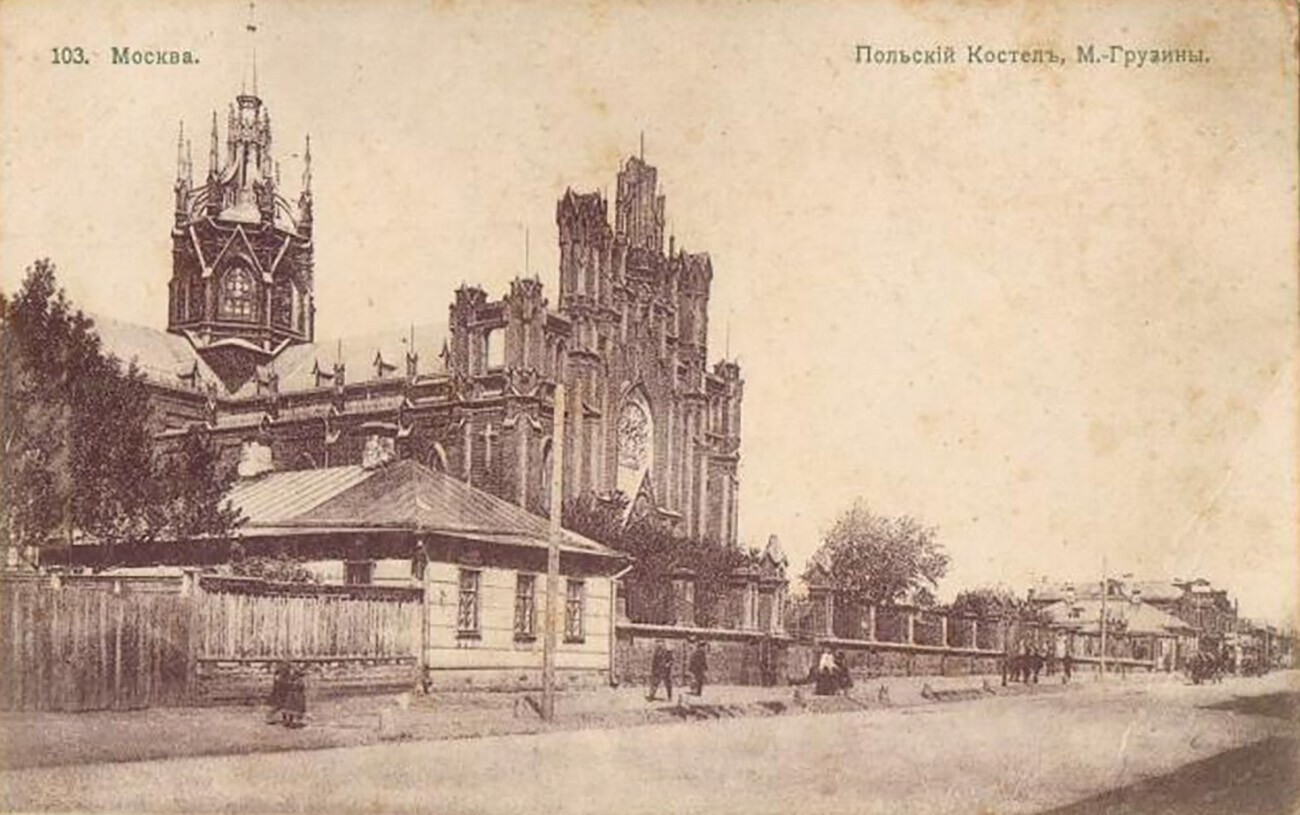
By the end of the 19th century, there were already two Catholic churches in Moscow, but they could no longer accommodate all the local Catholics, who totaled more than 30,000 people. They were mostly from Poland and worked on the Moscow-Smolensk railroad. It was they who collected funds and chose a plot of land near the Belorusskaya railway station (as it’s called today).
It was a place on the outskirts of Moscow back then, quite far from the center and important Orthodox Christian shrines, so the city authorities gave permission to build a church designed to fit as many as 5,000 people! For comparison, the original Cathedral of Christ the Savior before its demolition could hold just over 7,000 people.

Christmas Mass at the Catholic Cathedral of the Immaculate Conception of the Blessed Virgin Mary in Moscow
Mikhail Tereshchenko/TASSBy the beginning of the 20th century, the population of Catholics in Moscow and throughout Russia had grown even bigger than when the church was conceived. In 1905, Nicholas II issued a manifesto on religious tolerance and, now, not only Poles could become parishioners of the cathedral. The number of Catholics multiplied, because Russian citizens were now no longer afraid to accept the Greek Catholic faith, with many converting to it from Orthodoxy.
Until 1919, the new church was only a branch of the older Moscow Church of the Holy Apostles Peter and Paul (now inactive). And then, it was given independence.
The author of the church project was architect Thomas Bogdanovich-Dvorzhetsky, a representative of an ancient Polish noble family. And, although Moscow authorities set a condition for the absence of decorations, towers and sculptures, the architect violated all stipulations. Dvorzhetsky was inspired by the outlines of Westminster Abbey in London and the Milan Cathedral.

Cathedral on an early 20th century postcard
Public domainAt the turn of the 19th and 20th centuries, the pseudo-historical styles (as neo-Russian) was in vogue, so it is quite logical that, in the construction of the Catholic cathedral, the architect focused on medieval Gothic. So, he added lancet arches, towers pointing upwards and cross-colored ornaments.
The huge church dedicated to the Immaculate Conception of the Virgin Mary began construction in 1899, but was consecrated only 12 years later, in 1911. The work on the interior decoration, meanwhile, continued for more than five more years.
Persecution of religion began in Russia immediately after the 1917 Bolshevik Revolution. In 1938, the cathedral was closed, all valuables were confiscated and the priest, a Pole named Michael Tsakul, was executed for alleged espionage.
The cathedral went through lots of periods during the Soviet years. There were fires and, during World War II, the church was heavily damaged by bombing. After the war, the towers and spires were demolished and not much of the original appearance of the church remained.

Industrial design bureau (‘Mosspetspromproekt’), the early 1990s
Stalislav Panov/TASSThe huge interior space was divided into floors and separate offices. The warehouses were arranged on the first floor (including a vegetable depot), some floors were used as dormitories, others were used by the industrial design bureau (‘Mosspetspromproekt’).
During perestroika, when religion in the USSR had already been reauthorized and churches began to be given back to churches of different denominations, the Polish diaspora asked for the return of the Church of the Immaculate Conception. Polish priest Tadeusz Pikus conducted the first service right on the steps of the church in 1990. Several thousand people gathered on the territory in front of the temple then.

Parishioners during the Easter celebration at the Catholic Cathedral of the Immaculate Conception of Holy Virgin Mary in Moscow.
Ilya Pitalev/SputnikHowever, ‘Mosspetspromproekt’ only moved out in 1996 and with a scandal. The community had to ask President Boris Yeltsin personally for help. By 1999, the restoration of the church was finally completed. Now, it is the cathedral of the Archdiocese of the Mother of God (i.e. the branch of the Roman Catholic Church in Moscow) and services are conducted here in several languages and you can even watch online broadcasts.
In 2021, a Russian priest named Father Dmitry Novoseletsky became the rector of the church for the first time. The church also houses one of the largest brass organs in Russia and regularly hosts organ concerts.
During the Soviet era, the interior of the church, of course, suffered greatly and many decorative elements were lost and not restored even during the restoration. For example, the altar was very much changed. Before the revolution it was a small copy of the cathedral looking like a Gothic composition with three spires.

Altar before the 1917 revolution and now
Public domain; Vitaly Belousov/SputnikNow the main part of the altar is a wooden cross with a plaster figure of Jesus Christ and figures of the Mother of God and Evangelist John on the edges of the altar made by Svyatoslav Zakhlebin.
Particles of relics of saints are placed in the altar now, including Apostle Andrew, and the most important, a particle of the veil of the Blessed Virgin Mary, to whom the temple is dedicated. Archbishop Tadeusz Kondrusiewicz, who has done much to return the church to the faithful, accepted these holy relics as a gift from the Cathedral of Verona.
Dear readers,
Our website and social media accounts are under threat of being restricted or banned, due to the current circumstances. So, to keep up with our latest content, simply do the following:
If using any of Russia Beyond's content, partly or in full, always provide an active hyperlink to the original material.
Subscribe
to our newsletter!
Get the week's best stories straight to your inbox